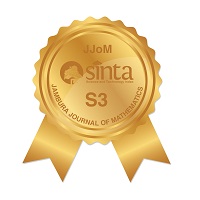SEIQR Model Sensitivity and Bifurcation Analysis of SARS-CoV-2 Dynamics with International in-out Mobility Control in Indonesia
Abstract
Keywords
Full Text:
PDFReferences
H. Ouassou et al., "The Pathogenesis of Coronavirus Disease 2019 (COVID-19): Evaluation and Prevention" J. Immunol. Res., vol. 2020, pp. 1-7, Jul. 2020, doi: 10.1155/2020/1357983.
Kementerian Kesehatan Republik Indonesia, "COVID-19 Situation in Indonesia." Accessed: Jan. 23, 2023. [Online]. Available: https://covid19.go.id.
Gugus Tugas Percepatan Penanganan Covid-19, "Pedoman Pencegahan dan Pengendalian Coronavirus Disease 2019 (COVID-19)." Accessed: Jan. 23, 2023. [Online]. Available: https://covid19.go.id/p/regulasi.
F. Ndaïrou, I. Area, J. J. Nieto, and D. F. M. Torres, "Mathematical modeling of COVID-19 transmission dynamics with a case study of Wuhan" Chaos Solitons Fractals, vol. 135, p. 109846, Jun. 2020, doi: 10.1016/j.chaos.2020.109846.
O. J. Peter, A. A. Ayoade, A. I. Abioye, A. A. Victor, and C. E. Akpan, "Sensitivity analysis of the parameters of a cholera model" J. Appl. Sci. Environ. Manag., vol. 22, no. 4, p. 477, May 2018, doi: 10.4314/jasem.v22i4.6.
H.-F. Huo, P. Yang, and H. Xiang, "Stability and bifurcation for an SEIS epidemic model with the impact of media" Phys. Stat. Mech. Its Appl., vol. 490, pp. 702-720, Jan. 2018, doi: 10.1016/j.physa.2017.08.139.
S. Annas, Muh. Isbar Pratama, Muh. Rifandi, W. Sanusi, and S. Side, "Stability analysis and numerical simulation of SEIR model for pandemic COVID-19 spread in Indonesia" Chaos Solitons Fractals, vol. 139, p. 110072, Oct. 2020, doi: 10.1016/j.chaos.2020.110072.
R. Resmawan, A. R. Nuha, and L. Yahya, "Analisis dinamik model transmisi COVID-19 dengan melibatkan intervensi karantina" Jambura J. Math, vol. 3, no. 1, pp. 66-79, 2021, doi: 10.34312/jjom.v3i1.8699.
A. Zeb, E. Alzahrani, V. S. Erturk, and G. Zaman, "Mathematical Model for Coronavirus Disease 2019 (COVID-19) Containing Isolation Class" BioMed Res. Int., vol. 2020, pp. 1-7, Jun. 2020, doi: 10.1155/2020/3452402.
I. Darti, Trisilowati, M. Rayungsari, R. R. Musafir, and A. Suryanto, "A SEIQRD epidemic model to study the dynamics of COVID-19 disease" Commun. Math. Biol. Neurosci., 2023, doi: 10.28919/cmbn/7822.
O. E. Deeb and M. Jalloul, "The Dynamics of COVID-19 spread: Evidence from Lebanon" Math. Biosci. Eng., vol. 17, no. 5, pp. 5618-5632, 2020, doi: 10.3934/mbe.2020302.
C. E. Madubueze, S. Dachollom, and I. O. Onwubuya, "Controlling the Spread of COVID-19: Optimal Control Analysis" Comput. Math. Methods Med., vol. 2020, pp. 1-14, Sep. 2020, doi: 10.1155/2020/6862516.
R. Resmawan and L. Yahya, "Sensitivity analysis of mathematical model of coronavirus disease (COVID-19) transmission" CAUCHY: Jurnal Matematika Murni dan Aplikasi, vol. 6, no. 2. pp. 91-99, 2020, doi: 10.18860/ca.v6i2.9165.
T. Hussain, M. Ozair, F. Ali, S. U. Rehman, T. A. Assiri, and E. E. Mahmoud, "Sensitivity analysis and optimal control of COVID-19 dynamics based on SEIQR model" Results Phys., vol. 22, p. 103956, Mar. 2021, doi: 10.1016/j.rinp.2021.103956.
M. Parsamanesh and M. Erfanian, "Stability and bifurcations in a discretetime SIVS model with saturated incidence rate" Chaos Solitons Fractals, vol. 150, p. 111178, Sep. 2021, doi: 10.1016/j.chaos.2021.111178.
L. P. Sinaga, D. Kartika, A. D. R. Sianipar, and R. L. Purba, "Stability analysis of modified SEIQR on dynamics of SARS-CoV-2 with control on vaccination, quarantine and international in-out mobility in Indonesia" in The 9th Annual International Seminar on Trends in Science and Science Education (AISTSSE) 2022, Sciendo, 2023, pp. 534-544. doi: 10.2478/9788367405195-069.
Kementerian Kesehatan Republik Indonesia, "Pedoman Pencegahan dan Pengendalian Coronavirus Disease (COVID-19)." Kementerian Kesehatan Republik Indonesia, Jul. 13, 2020. Accessed: Jan. 23, 2023. [Online]. Available: https://infeksiemerging.kemenkes.go.id/document-pencegahandan-pengendalian-covid-19/view.
L. Perko, Differential equations and dynamical systems, 3rd ed. in Texts in applied mathematics, no. 7. New York: Springer, 2001.
R. C. Dorf and R. H. Bishop, Modern control systems, Thirteenth edition. Hoboken: Pearson, 2016.
P. Van Den Driessche and J. Watmough, "Reproduction numbers and subthreshold endemic equilibria for compartmental models of disease transmission" Math. Biosci., vol. 180, no. 1-2, pp. 29-48, Nov. 2002, doi: 10.1016/S0025-5564(02)00108-6.
N. Chitnis, J. M. Hyman, and J. M. Cushing, "Determining Important Parameters in the Spread of Malaria Through the Sensitivity Analysis of a Mathematical Model" Bull. Math. Biol., vol. 70, no. 5, pp. 1272-1296, Jul. 2008, doi: 10.1007/s11538-008-9299-0.
C. Castillo-Chavez, B. Song, 1. Mathematics, Computational and Modeling Sciences Center, Arizona State University, PO Box 871904, Tempe, AZ 85287, and 2. Department of Mathematical Sciences, Montclair State University, Upper Montclair, NJ 07043, "Dynamical Models of Tuberculosis and Their Applications" Math. Biosci. Eng., vol. 1, no. 2, pp. 361-404, 2004, doi: 10.3934/mbe.2004.1.361.
C. Elik, "Bifurcation Analysis and Its Applications" in Numerical Simulation - From Theory to Industry, M. Andriychuk, Ed., InTech, 2012. doi: 10.5772/50075.
DOI: https://doi.org/10.37905/jjom.v6i1.23426
Copyright (c) 2024 Lasker Pangarapan Sinaga, Dinda Kartika, Nurul Ain Farhana

This work is licensed under a Creative Commons Attribution-NonCommercial 4.0 International License.
Jambura Journal of Mathematics has been indexed by
Jambura Journal of Mathematics (e-ISSN: 2656-1344) by Department of Mathematics Universitas Negeri Gorontalo is licensed under a Creative Commons Attribution-NonCommercial 4.0 International License. Powered by Public Knowledge Project OJS.
Editorial Office
Department of Mathematics, Faculty of Mathematics and Natural Science, Universitas Negeri Gorontalo
Jl. Prof. Dr. Ing. B. J. Habibie, Moutong, Tilongkabila, Kabupaten Bone Bolango, Gorontalo, Indonesia
Email: [email protected].



















